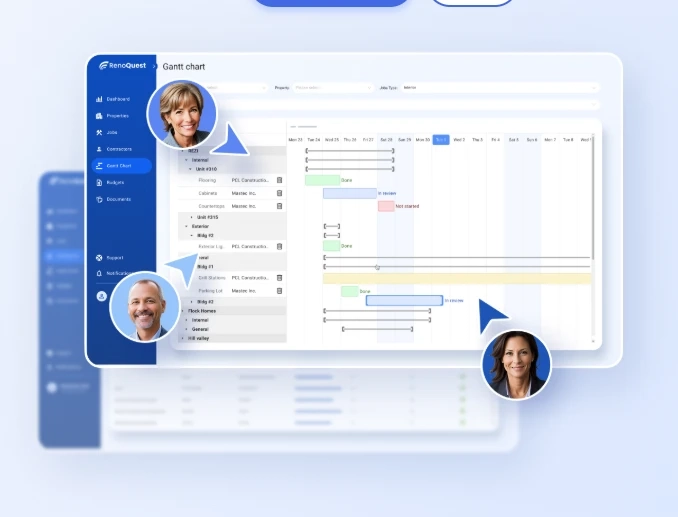The home renovation industry has witnessed significant advancements in recent years, with one of the most notable innovations being the rise of renovation software. These digital tools are transforming how homeowners, contractors, and designers approach the often complicated, time-consuming, and expensive process of home renovation. Whether you're looking to update a single room or completely overhaul a property, renovation software can be a game-changer, offering everything from project management to design assistance and budgeting tools. In this article, we'll explore the benefits and features of renovation software, and why it’s becoming a must-have for anyone embarking on a renovation journey.
What is Renovation Software?
Renovation software is a type of digital tool designed to streamline and manage the entire renovation process. It typically encompasses various functionalities such as design, budgeting, scheduling, and communication management, helping homeowners, contractors, and designers stay organized and on track. These platforms can be used to create digital blueprints, track progress, calculate costs, and manage timelines.
The most significant advantage of renovation software is that it combines all the necessary tools into one cohesive platform. It reduces the need for multiple apps and physical paperwork, offering an all-in-one solution that enhances efficiency and accuracy throughout the renovation process.
Features of Renovation Software
- Design Capabilities: One of the most appealing features of renovation software is its ability to help users visualize their projects. With design tools, users can create floor plans, experiment with different layouts, and try out various materials and finishes before committing to any decisions. The software allows for 3D modeling, giving users a realistic representation of how their space will look once the renovation is completed. Some platforms even allow users to simulate changes in lighting, furniture placement, and other elements that can significantly impact the look and feel of a room.
- Budgeting and Cost Estimation: Renovating a home can be an expensive endeavor, and one of the most challenging aspects is staying within budget. Renovation software often includes features that help users calculate costs based on materials, labor, and other expenses. Some platforms provide cost estimators that give users a clear idea of how much each part of the project will cost. This can help homeowners avoid surprises and make more informed decisions when selecting materials and contractors.
- Project Management and Scheduling: Staying organized is essential when managing a renovation project. Renovation software typically includes project management tools that help users track the progress of their renovation. You can set milestones, create timelines, and monitor tasks to ensure that everything is completed on schedule. With real-time updates, all team members, including contractors and designers, can stay on the same page and avoid delays.
- Collaboration Tools: Renovation projects often require a team of people, including contractors, interior designers, and architects. Renovation software allows these professionals to collaborate seamlessly, with shared access to documents, timelines, and designs. It ensures everyone is working from the same information, which reduces the likelihood of errors and miscommunication.
- Document Storage and Organization: Home renovation projects often involve a lot of paperwork, such as permits, contracts, invoices, and receipts. Renovation software can store and organize these documents digitally, making them easy to access whenever needed. This eliminates the need for physical filing systems and helps users stay organized throughout the renovation process.
- Vendor and Contractor Management: Renovation software can simplify the process of selecting and managing vendors and contractors. It allows users to track contractors' work schedules, manage payment processes, and evaluate their performance. By keeping all vendor-related information in one place, homeowners can easily compare quotes, check references, and ensure they are getting the best value for their money.
- Compliance and Permits: Navigating local building codes and obtaining permits can be a headache for many renovators. Renovation software often includes tools that help ensure that projects comply with local regulations. Some platforms provide guidance on necessary permits, helping users avoid fines or delays that could occur if they don't adhere to local building codes.
Benefits of Using Renovation Software
- Increased Efficiency: The most significant advantage of renovation software is the increased efficiency it offers. By having all your project management tools in one place, you can reduce the time spent on administrative tasks, allowing you to focus on the creative and construction aspects of your project. Instead of flipping through paper documents or multiple apps, everything is streamlined and easily accessible.
- Better Visualization: One of the most exciting benefits of renovation software is its ability to help users visualize their renovations before committing to them. Whether you are redesigning a kitchen or remodeling your bathroom, seeing a 3D representation of your ideas can help you make more informed decisions. It allows you to experiment with different layouts, materials, and colors, ensuring you’re completely happy with the final design.
- Accurate Budgeting: Accurate budgeting is essential to the success of any renovation project. Renovation software allows you to track your spending in real time, ensuring you don't exceed your budget. It also helps you prioritize your spending, allowing you to make smart decisions about where to allocate your funds.
- Improved Communication: Renovation software helps improve communication between all parties involved in the project. Contractors, designers, and homeowners can easily share information, updates, and feedback, ensuring that everyone is on the same page. This reduces the likelihood of misunderstandings and delays, helping projects stay on track.
- Reduced Errors: Human error is always a risk in renovation projects, whether it's a mistake in the measurements or miscommunication between contractors. Renovation software reduces the chances of errors by providing a structured, organized approach to the project. With detailed designs, accurate cost estimations, and clear timelines, users are less likely to make costly mistakes.
- Easy Document Management: Home renovation involves a lot of paperwork, and managing these documents can be a hassle. Renovation software simplifies this by storing and organizing contracts, permits, receipts, and invoices in one place. This makes it easy to access important documents whenever needed, keeping everything organized and easily retrievable.
- Customizable to Your Needs: Different renovation projects have different requirements, and renovation software is often highly customizable to fit the specific needs of your project. Whether you are working on a large-scale renovation or a small remodel, you can tailor the software to suit the scope and scale of your work.
How Renovation Software Benefits Homeowners
For homeowners, renovation software can make the entire process of remodeling a home less stressful and more rewarding. Some of the primary benefits include:
- Reduced Stress: Renovation projects can be overwhelming, especially for those who have never undertaken such a large-scale undertaking before. With renovation software, homeowners can break down the project into manageable tasks, track progress, and ensure that everything is on track. This reduces stress and makes the renovation process much more enjoyable.
- Increased Control: Homeowners often feel disconnected from the renovation process, especially when they rely on contractors and designers. Renovation software allows homeowners to be more involved in the project by giving them access to real-time updates, designs, and budgets. This empowers them to make informed decisions and stay in control of the project.
- Better Decision Making: With all the necessary information at their fingertips, homeowners can make better decisions about design, materials, and contractors. They can experiment with different design options, get accurate cost estimates, and collaborate with professionals, ensuring that they make the best choices for their renovation.
The Future of Renovation Software
As technology continues to evolve, renovation software will become even more advanced. Future innovations may include virtual and augmented reality, which will take design and visualization to the next level. AI and machine learning could be integrated to provide even more accurate cost estimates, while automation could streamline tasks like scheduling and budgeting.
Additionally, with the increasing emphasis on sustainability and eco-friendly home renovations, renovation software may include features that help homeowners select environmentally friendly materials and design energy-efficient homes.
Conclusion
Renovation software is an indispensable tool for anyone embarking on a home improvement project. It helps streamline the process, improve communication, and enhance decision-making, ultimately leading to better results. Whether you're a homeowner, contractor, or designer, using renovation software can save you time, money, and stress while improving the overall quality of your renovation. So, if you’re planning a renovation project, consider leveraging renovation software to bring your vision to life with greater efficiency and accuracy.



